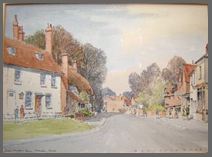 WICKED
WICKED
Do not oblige him to read any more. Have mercy on him, tell him the truth, and make him an apology. He and I should not in the least agree, of course, in our ideas of novels and heroines. Pictures of perfection, as you know, make me sick and wicked; but there is some very good sense in what he says, and I particularly respect him for wishing to think well of all young ladies; it shows an amiable and a delicate mind. And he deserves better treatment than to be obliged to read any more of my works. Letter to her Niece Fanny Knight, 23 March 1817, The Letters of Jane Austen
Fanny Knight was Jane Austen’s first and most favoured niece. She was born when Jane was 17 years old in 1793, the eldest daughter of Jane’s brother Edward (Austen) Knight. She adored her and she was like a younger sister.
 Much has be discussed and written about their relationship, including this book Almost Another Sister: The Story of Fanny Knight, Jane Austen ‘s Favourite Niece, by Margaret Wilson (1998), which is sadly out of print in the US, but can be ordered second hand through those wonderful people at AbeBooks.com. Search here . Happily, there is an excellent review of the book by author Marilyn Sachs at the JASNA on-line journal Persuasions, entitled Austen’s Ungrateful Niece.
Much has be discussed and written about their relationship, including this book Almost Another Sister: The Story of Fanny Knight, Jane Austen ‘s Favourite Niece, by Margaret Wilson (1998), which is sadly out of print in the US, but can be ordered second hand through those wonderful people at AbeBooks.com. Search here . Happily, there is an excellent review of the book by author Marilyn Sachs at the JASNA on-line journal Persuasions, entitled Austen’s Ungrateful Niece.
Five letters that Jane wrote to Fanny between 1814 and 1817 are filled with wise and eloquent advice on love, and openly acknowledge the deep affection she felt for her niece.
When one reads their correspondence, one often feels through their affection and concern for each other that Fanny Knight was the daughter that Jane Austen did not have.
So it is not surprising that Janeites are outraged by a letter written by Fanny, now Lady Knatchbull, in 1869, describing Jane as “very much below par as to good society and its ways.” Fanny believes that it was only due to her rich father and his superior connections that her aunt was rescued from “commonness and a lack of refinement.”
 Well, well. The reference to Fanny’s rich father is of course Jane Austen’s brother Edward (Austen) Knight who was not wealthy until he was adopted in 1798 by Thomas and Catherine Knight, Austen family cousins who were titled gentry and childless. They owned the vast estates of Godmersham Park, Kent and Chawton, Hants, which Edward inherited. He would later suppy his widowed mother and sisters Cassandra and Jane a cottage in the village of Chawton in 1809. Here is a listing for the (Austen) Knight family at Peerage.com. Sir Walter Elliot, Baronet of Jane Austen’s novel Persuasion would take express interest in the Knight family listing in A Genealogical and Heraldic Dictionary of the Landed Gentry of Great Britian.
Well, well. The reference to Fanny’s rich father is of course Jane Austen’s brother Edward (Austen) Knight who was not wealthy until he was adopted in 1798 by Thomas and Catherine Knight, Austen family cousins who were titled gentry and childless. They owned the vast estates of Godmersham Park, Kent and Chawton, Hants, which Edward inherited. He would later suppy his widowed mother and sisters Cassandra and Jane a cottage in the village of Chawton in 1809. Here is a listing for the (Austen) Knight family at Peerage.com. Sir Walter Elliot, Baronet of Jane Austen’s novel Persuasion would take express interest in the Knight family listing in A Genealogical and Heraldic Dictionary of the Landed Gentry of Great Britian.
Of note is the fact that Lady Fanny (Knight) Knatchbull was 77 years old when she wrote the letter in 1869, and from family accounts never expressed herself as eloquently as her aunt Jane, and was quite senile and forgetful for some years prior. This may have been the families way of dismissing this disparaging remark by a niece who Jane dearly loved. My thought is that Jane would have laughed at the comment since “pictures of perfection” made her “sick and wicked“! Further reading on that ungrateful niece Fanny and her infamous slam can be found on these excellent links and books.
-
A Glimps of Jane Austen: Jane Austen’s World
-
Fanny Knight’s Diaries: by Deirdre le Faye (a review) at JASA
-
The Jane Austen Centre: Academic Works about Jane Austen
*Image of a hand tinted engraving of Godmersham Park, by W. Watts, from Edward Hasted’s History of Kent (1799)